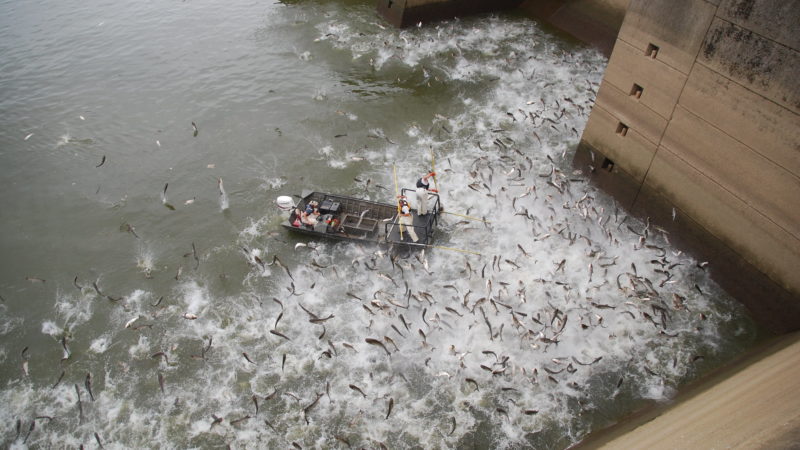Project Report: Conversion of a Cargo Vessel into a Mobile Aquaculture Farm
Executive Summary
A subsidiary of the China State Shipbuilding Corporation (CSSC) has successfully converted an 80,000 deadweight tonne bulk carrier into a mobile fish farm. This initiative is a significant step in advancing China’s “marine bread basket” strategy, directly supporting several United Nations Sustainable Development Goals (SDGs) by enhancing food security, promoting sustainable marine practices, and fostering industrial innovation.
Alignment with Sustainable Development Goals (SDGs)
SDG 2: Zero Hunger
The project directly addresses the goal of achieving food security and promoting sustainable agriculture by creating a new, high-yield source of protein.
- Enhanced Food Production: The converted vessel, named Zhe Dai Yu Yang 60001, is projected to produce 2,800 tonnes of fish annually, contributing significantly to the national food supply.
- Strengthening Self-Sufficiency: This initiative bolsters China’s food security amidst global challenges such as climate change and geopolitical instability, reducing reliance on external food sources.
- Meeting Growing Demand: The mobile farm helps satisfy the nation’s increasing appetite for seafood, a key component of the national diet.
SDG 14: Life Below Water
By moving aquaculture into a controlled, mobile environment, the project supports the conservation and sustainable use of marine resources.
- Reduced Pressure on Wild Stocks: Cultivating fish in a contained system alleviates pressure on over-exploited wild fish populations in traditional fishing grounds.
- Sustainable Aquaculture Model: The use of seawater-exchange technology represents a more sustainable approach to aquaculture, potentially minimizing the ecological impact often associated with coastal fish farms.
SDG 9: Industry, Innovation, and Infrastructure & SDG 12: Responsible Consumption and Production
The conversion exemplifies innovation in infrastructure and promotes circular economy principles for responsible production.
- Innovative Repurposing of Infrastructure: The transformation of a 225-metre-long cargo ship into a productive fish farm is a prime example of industrial innovation, adapting existing assets for new, sustainable purposes.
- Circular Economy Application: Reusing an old vessel instead of scrapping it extends its operational life, reduces waste, and embodies the principles of responsible consumption and production.
- Technological Empowerment: The project is the result of a long-term strategy, initiated by CSSC in 2017, to develop and apply new technologies to empower marine development.
Project Details and Strategic Context
- Vessel Specifications: The Zhe Dai Yu Yang 60001 is a former bulk carrier measuring 225 metres in length and 32.2 metres in width.
- Conversion Timeline: The refitting process for the vessel was completed in approximately three months.
- Strategic Imperative: This project is a key component of China’s broader goal to build a resilient “marine bread basket,” ensuring a stable food supply through technological advancement and strategic resource management.
Analysis of Sustainable Development Goals (SDGs) in the Article
1. Which SDGs are addressed or connected to the issues highlighted in the article?
-
SDG 2: Zero Hunger
The article directly addresses food security, a central theme of SDG 2. It states the project’s aim is to “boost the nation’s food security” and build a “marine bread basket’ to strengthen the nation’s food supply.” This initiative is a direct response to the need for self-sufficiency in food production.
-
SDG 9: Industry, Innovation and Infrastructure
The project is an example of industrial innovation and infrastructure adaptation. The article describes it as an “innovative practice by CSSC to empower marine development with technology” and involves the conversion of a “hulking bulk carrier,” which is a significant piece of infrastructure, for a new purpose.
-
SDG 12: Responsible Consumption and Production
The core concept of “repurposing old vessels for use in aquaculture” aligns with the principles of a circular economy and sustainable production patterns. The article highlights that CSSC has been leading a project to “explore the reuse of old vessels,” which directly relates to reducing waste and making efficient use of existing resources.
-
SDG 14: Life Below Water
The article focuses on aquaculture as a solution to the pressure on “local fish stocks” caused by a “growing appetite for seafood.” By developing controlled fish farming, the project aims to provide an alternative to wild-capture fishing, thereby contributing to the sustainable use of marine resources.
2. What specific targets under those SDGs can be identified based on the article’s content?
-
SDG 2: Zero Hunger
- Target 2.1: End hunger and ensure access to safe, nutritious and sufficient food. The project’s goal to “boost the nation’s food security” and “strengthen the nation’s food supply” directly supports this target by increasing the availability of fish.
- Target 2.4: Ensure sustainable food production systems. The mobile fish farm represents a new, technologically advanced food production system designed to be a more sustainable alternative to depleting wild fish stocks.
-
SDG 9: Industry, Innovation and Infrastructure
- Target 9.4: Upgrade infrastructure and retrofit industries to make them sustainable. The conversion of an old cargo ship into a fish farm is a clear example of retrofitting industrial assets for a new, productive, and potentially more sustainable purpose.
- Target 9.5: Enhance scientific research and upgrade technological capabilities. The project is described as an “innovative practice” that uses “technology” to “empower marine development,” indicating an investment in research and technological advancement in the aquaculture sector.
-
SDG 12: Responsible Consumption and Production
- Target 12.5: Substantially reduce waste generation through prevention, reduction, recycling and reuse. The project’s central theme is the “reuse of old vessels,” which is a direct application of this target, preventing a large ship from becoming waste and giving it a new life cycle.
-
SDG 14: Life Below Water
- Target 14.4: Effectively regulate harvesting and end overfishing. By providing an alternative source of seafood through aquaculture, the project helps alleviate pressure on “local fish stocks,” contributing indirectly to the goal of ending overfishing.
- Target 14.a: Increase scientific knowledge, develop research capacity and transfer marine technology. The project is an explicit example of applying new technology (“seawater-exchange aquaculture”) to marine development, thereby increasing technological capacity in this field.
3. Are there any indicators mentioned or implied in the article that can be used to measure progress towards the identified targets?
-
Indicators for SDG 2 (Zero Hunger)
- Food Production Volume: The article specifies that the ship will be “used to produce up to 2,800 tonnes of fish per year.” This quantifiable output is a direct indicator of increased food supply.
-
Indicators for SDG 9 (Industry, Innovation and Infrastructure)
- Investment in R&D: The mention of a project led by CSSC “since 2017” to “explore the reuse of old vessels” implies a long-term investment in research and development.
- Scale of Retrofitted Infrastructure: The physical dimensions of the ship (“225 metres in length and 32.2 metres in width”) serve as a tangible indicator of the scale of infrastructure being repurposed.
-
Indicators for SDG 12 (Responsible Consumption and Production)
- Number of Reused Units: The conversion of one “giant cargo ship” is a specific, countable instance of reuse. The article implies this is part of a larger project, so the number of ships converted over time would be a key indicator.
-
Indicators for SDG 14 (Life Below Water)
- Aquaculture Production: The “2,800 tonnes of fish per year” is a direct indicator of the contribution of aquaculture to the overall fish supply, which can be measured against wild catch data to assess its impact on relieving pressure on marine ecosystems.
- Adoption of New Technology: The implementation of “seawater-exchange aquaculture” on a repurposed vessel is an indicator of the development and application of new marine technology.
4. Summary Table of SDGs, Targets, and Indicators
| SDGs | Targets | Indicators |
|---|---|---|
| SDG 2: Zero Hunger | 2.1: Ensure access to sufficient food. 2.4: Ensure sustainable food production systems. |
Annual production capacity of 2,800 tonnes of fish. |
| SDG 9: Industry, Innovation and Infrastructure | 9.4: Upgrade infrastructure and retrofit industries. 9.5: Enhance scientific research and technology. |
Conversion of an 80,000 deadweight tonne cargo ship; Project to “explore the reuse of old vessels” ongoing since 2017. |
| SDG 12: Responsible Consumption and Production | 12.5: Substantially reduce waste generation through reuse. | The “reuse of old vessels” as a central project concept. |
| SDG 14: Life Below Water | 14.4: End overfishing. 14.a: Increase scientific knowledge and transfer marine technology. |
Development of aquaculture as an alternative to depleting “local fish stocks”; Implementation of “seawater-exchange aquaculture” technology. |
Source: scmp.com






